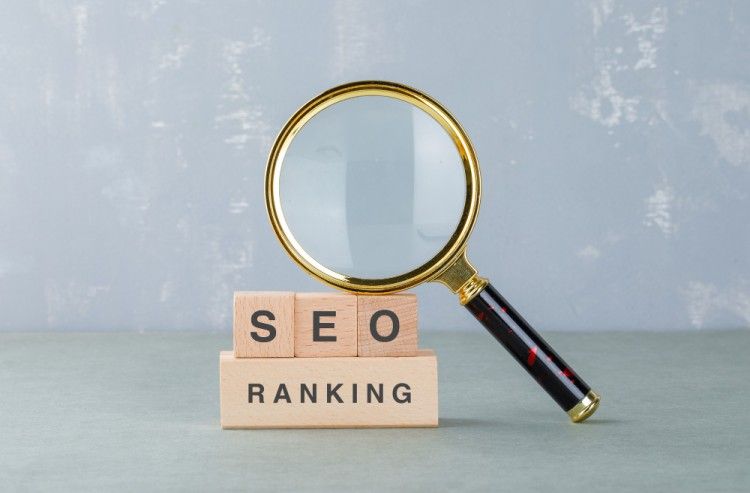Your website is the digital face of your business, reaching not just your core audience but a global audience. As per a study conducted by Stanford University, a substantial 94% of initial impressions for a website are directly tied to design factors. As your business adapts and grows, your website should evolve into a dynamic tool supporting your sales, marketing, and support teams.

Maintaining your website in top form is paramount in today's digital age. Whether planning a partial update or a complete transformation with website redesign services, we want you to know that you're investing in a foundational aspect of your business.
1. Outdated Design
- Cluttered Layout: An overcrowded or disorganized design can overwhelm visitors. When your website is too busy, it becomes easier for users to focus on critical information or products, leading to frustration and high bounce rates.

Credit A cluttered website is characterized by an excess of pages and overly complex design elements, often featuring distracting images or excessive ads. These sites can confuse users by making it unclear where to focus or how to engage, which is not uncommon online. We recommend that you choose affordable website redesign solutions to manage those issues. - Obsolete Aesthetics: Web design trends change rapidly. An outdated look can convey that your business needs to be keeping up with the times or that you need to invest in your online presence. Visitors might question whether your products or services need to be updated. A significant 38.5% of web designers consider outdated design a leading cause of website visitor attrition.
- Unresponsive Design: With the increasing use of mobile devices for internet access, a website that needs to be mobile-responsive is a significant drawback. Approximately 53.8% of web designers identify a 'lack of responsiveness on all devices' as a primary reason necessitating a website redesign. Users want a seamless experience, no matter what the device is. An unresponsive site can result in a loss of potential customers.
- Impatience of Users: Users expect instant gratification. Recent research conducted by Google reveals that 53% of mobile website visitors will exit a webpage if it fails to load within a three-second timeframe. Slow loading times can frustrate visitors and lead to high bounce rates.
- Impact on SEO: Google considers page speed as a ranking factor. Slow-loading pages can significantly reduce your search engine rankings. Thus, it can be difficult for potential customers to find your site.
- First Impressions Matter: High bounce rates, where visitors quickly leave your site after landing, often indicate issues with your website's engagement and relevance. Users are forming negative first impressions.
- Complex Navigation Menus: If users struggle to navigate your website due to confusing navigation menus, it's a strong signal that a redesign is necessary. Your navigation should be intuitive and user-friendly.
- Lack of Search Functionality: An intuitive search bar can significantly improve user experience by helping visitors find what they need quickly. Without it, users may get frustrated and leave your site searching for a more user-friendly alternative. Getting website redesign services will enable you to solve this problem efficiently.
- Call-to-Action (CTA) Issues: If your website needs clear and compelling CTAs or needs to be better placed, your conversion rates may suffer. A well-designed website should guide visitors toward taking desired actions, whether it's to make a purchase, fill out a proper contact form, or sign up for newsletters.
- Forms and Checkout Process: A cumbersome checkout process or forms that ask for too much information can deter potential customers. Simplifying these processes during a redesign can boost conversion rates significantly.
- Outdated SEO Practices: Search engines, like Google, will always update the algorithms so that users are provided with the best and highest-quality options. If your website uses outdated SEO practices, it means that it's employing techniques that were once effective but have yet to be in line with current search engine guidelines.
- Keyword Relevance: Optimizing your website's content is one of the foundational aspects of SEO. In general, a website tends to receive higher traffic as it ranks for more keywords. Did you know almost 94.74% of keywords receive ten or fewer monthly searches? Choose relevant keywords and phrases that your target audience might search for. If your website lacks keyword relevance, your content isn't effectively targeting the keywords that can drive organic (unpaid) traffic to your site. By hiring website revamp services, you can reevaluate your keyword strategy.
- Data Breach Issues: With cyber threats rising, an unsafe website can put your business and customers at risk. Ensuring that your website is up-to-date with the latest security measures is crucial.
- SSL Certificate: If your website lacks an SSL certificate (resulting in an HTTP instead of HTTPS), it can affect your site's trustworthiness. Visitors may be hesitant to share sensitive information, and browsers might display security warnings, deterring potential customers.
- Cross-browser Compatibility: Your website should work seamlessly on various browsers and devices to reach a broader audience. Incompatibility issues can result in a poor user experience and lost opportunities.
- Technological Advances: As new technologies emerge, your website should adapt to ensure optimal performance and compatibility. Staying current with web standards ensures your site functions well in the ever-changing digital landscape.
- Competitive Performance: Do your competitors seem to outshine your business when selling their products or services?
- Benchmarking and Assessment: To understand where you stand, it's essential to benchmark and assess your website in relation to others in your industry.
- Frequent Updates: An outdated website might require constant updates and patches, resulting in higher maintenance costs. Reach out for the best website revamp services to solve that issue firsthand.
- Ease of Management: A well-designed website with user-friendly content management systems can reduce maintenance efforts and costs. A redesign can streamline your website's management, making it more cost-effective in the long run.
- Stale Information: When your website contains outdated information, it can confuse and erode trust. Visitors may question the reliability of your business and wonder if you're still active or relevant.
- Impact on Authority: Fresh and relevant content is essential for establishing authority in your industry. Outdated content can make you appear less knowledgeable or authoritative than competitors who regularly update their information.
- Accessibility Compliance: In today's inclusive digital landscape, websites must be accessible to individuals with disabilities. If your website doesn't comply with accessibility standards, you risk estranging a slice of your audience and potential customers.
- Enhanced User Experience: Accessibility features, such as text-to-speech capabilities and keyboard navigation, not only make your website inclusive but also enhance the overall user experience for all visitors, leading to increased engagement and satisfaction.

2. Slow Loading Times

3. High Bounce Rate
4. Poor Navigation
5. Low Conversion Rates

6. Poor SEO Performance

7. Inadequate Security
8. Incompatibility with Modern Browsers
9. Comparing Your Business to the Competition
10. High Maintenance Costs
11. Outdated Content

12. Lack of Accessibility
Common Hesitations About A Site Redesign
It Might Be Too Expensive
One of the most common hesitations revolves around the perceived expense of a website redesign. Businesses worry that the cost may be prohibitive, especially for small and medium-sized enterprises. However, viewing site redesign as an investment rather than a cost is essential. Ignoring necessary updates can lead to higher long-term expenses, mainly if outdated features cause problems or security vulnerabilities.
It Takes So Much Time
Many businesses are hesitant to undertake a website redesign because they fear it will consume too much time and disrupt their daily operations. The misconception is that a redesign project will require excessive involvement from the business owner or staff, diverting attention from core responsibilities. However, with the right web development team, the process can be managed efficiently and with minimal disruption to the business.
What Is It Going To Turn Out Like?
Businesses often need help to redesign their websites due to concerns about the end result. They fear that the new design may not align with their vision or that it might not deliver the desired improvements in user experience and performance. This uncertainty can be mitigated through effective communication and collaboration with experienced web designers who can ensure that the redesign aligns with the business's goals and expectations.
What If The ROIs Aren’t Enough?
Another common hesitation centers around Return on Investment (ROI). Some businesses are unsure whether a website redesign will provide a substantial return on the investment. It's important to recognize that an updated and user-friendly website can lead to increased engagement, improved conversions, and a positive impact on branding, all of which contribute to long-term business success.
How Do I Even Begin?
Many businesses simply don't know where to start when it comes to professional website redesign. They may feel overwhelmed by the technical aspects and project scope. This hesitation can be addressed through initial consultations with web development experts who can provide guidance, assess the current website's strengths and weaknesses, and outline a clear project plan and timeline.
What If I Lose SEO Rankings?
Businesses that have invested in Search Engine Optimization (SEO) may be hesitant to redesign their websites due to concerns about losing their current search engine rankings. However, when executed correctly, a website redesign can improve SEO by addressing issues such as page speed, mobile responsiveness, and content optimization. SEO strategies can be adapted and integrated into the redesign process to minimize any negative impact on rankings.
Conclusion
Your website is a dynamic and crucial asset that requires regular attention and updates to remain effective in the ever-changing digital world. It is essential to learn the signals that show you it's time for a website redesign to stay competitive, provide a seamless user experience, and achieve your business goals. By addressing these issues and investing in efficient website redesign services, you can better engage your audience, improve your online presence, and ultimately drive business growth in today's digital age.
Frequently Asked Questions on Website Redesign
Ques 1. Why is it essential to consider a website redesign?
A website redesign is crucial because it ensures that your online presence remains relevant, appealing, and effective. As digital trends evolve, your website should keep pace to engage visitors, enhance user experience, and meet your business goals.
Ques 2. How can I tell if my website needs a redesign?
Several signs indicate the need for a website redesign, including outdated design, slow loading times, high bounce rates, poor navigation, low conversion rates, and more. This article outlines these signs in detail to help you assess your website's status.
Ques 3. What's the connection between slow loading times and SEO performance?
Slow-loading pages can negatively impact SEO because search engines consider page speed when ranking websites. Users want to abandon slow websites, leading to higher bounce rates and reduced search engine rankings.
Ques 4. How does a website redesign improve SEO performance?
During a website redesign, you can update content, improve site structure, and ensure mobile responsiveness, all of which positively influence SEO. You can also address outdated SEO practices and keyword relevance, aligning your site with modern SEO guidelines.
Ques 5. What are the important steps to a successful website redesign?
A successful website redesign involves planning, setting clear objectives, conducting thorough research, optimizing content and keywords, testing, and monitoring performance post-launch. Collaborating with experienced web designers and SEO experts can also enhance the process.

